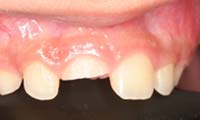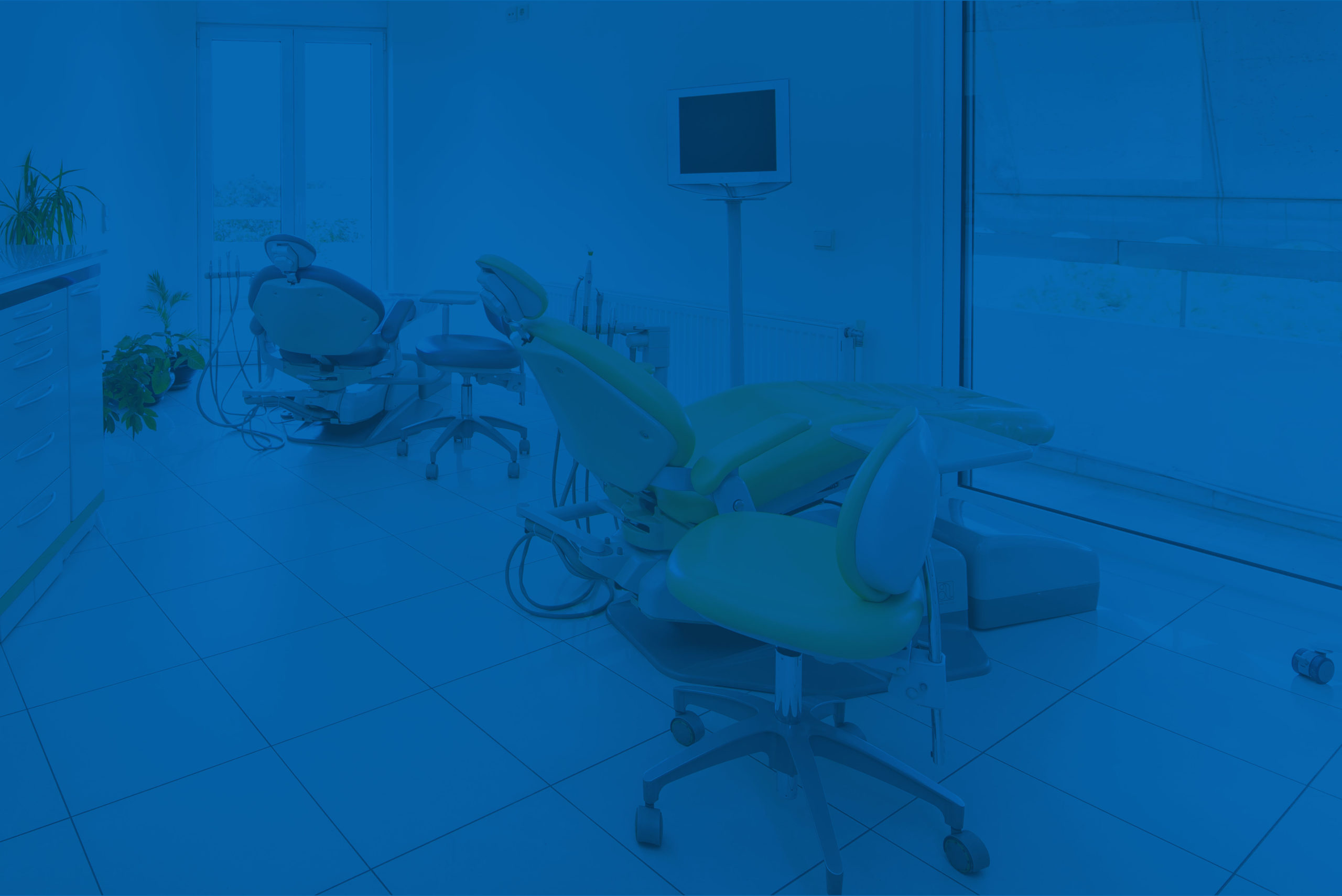At Dental Group we acknowledge that some groups of patients have particularities that require specialized care. Children constitute one such special group. At Dental Group there are specialized pediatric dentists who have the ability and knowledge to ensure a pleasant dental experience to children. Our aim is not only for our young patients to surpass their phobias and their negative past dental experiences. What we pursue is the formation of a pleasant, friendly and useful dental environment.
The pediatric dentist implementing his/her area of expertise and knowledge on childhood psychology and behavior can form, during the dental treatment sessions, a new dental culture that transforms the “pain monster” dentist to the doctor who painlessly takes care of the dental health. Thus, children from an early age learn to love the dentist, to build a relationship with the dentist based on trust and to pursue to always have strong and healthy teeth.

Parents should be aware of the fact that the early visit to the pediatric dentist is of critical importance for the future oral health of their children.
At Dental Group we consider the first visit of the child at the dental office of critical importance, because we believe that good habits regarding dental care are established at a very early stage of development and accompany the child throughout life. We also take care that the dental office environment is as pleasant as possible in order for the child’s experiences to be positive and beneficial.
The session may begin with a small tour at the facilities of the dental office and with an introduction to the pediatric dentist and the dentists of the Dental Group team. When the child becomes comfortable with the dental environment the pediatric dentist moves on to a brief or a thorough examination of the teeth and the mouth.
A basic part of the first visit is also to raise the parents’ awareness on issues like:
- the development, the erruption and the importance of deciduous and permanent teeth
- the problems that can be caused by poor nutritional habits
- the prevention against caries and gingivitis
- good oral hygiene practices
- the consequences of bad habits such as the sucking of the thumb or the extensive use of a pacifier
- the management of emergencies
As soon as the first permanent teeth emerge, the pediatric dentist will examine your child’s teeth and will inform you about fluoridation and the benefits of preventive fillings (sealants). A delay in the erruption of the permanent teeth will be monitored, while the need of preserving the space for the eruption of the permanent teeth will be evaluated.
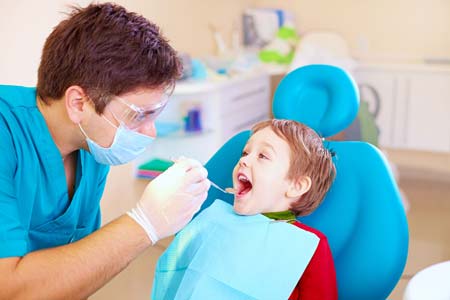
The first systematic orthodontic assessment regarding dental and skeletal problems takes place at the age of 7 years, in collaboration with the orthodontist.

The preventive fillings (sealants) smoothen out the grooves of the teeth and they function as a prevention measure towards the accumulation of food and the formation of microbial plaque, that is the cause of tooth caries. At the same time, they facilitate oral hygiene since the grooves of the teeth are now more shallow.
Procedure
The preventive fillings (sealants) are fillings that prevent the development of carious lesions. They are simple, painless and safe. They are placed on the tooth surfaces without removing any kind of dental material or substance. The placement of the sealants is a fast process and is completed in one appointment, without anesthesia. The procedure followed is as described below:
- cleaning and preparation of the tooth surface
- covering of the grooves of the teeth with composite resin
- photopolymerization for the bonding and hardening of the resin
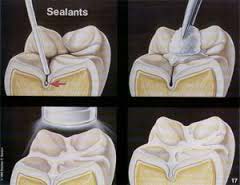
grooves of the teeth
Duration
The preventive fillings, generally, have a long life span if they have been placed correctly. Effective oral hygiene also plays an important role in the duration of the result. During the regular examinations, the dentist examines if the preventive sealants are intact or detached. In such a case and if necessary, the sealant fillings are usually replaced.
Preventive fillings (Sealants) for children
The preventive fillings are recommended especially to children because of the higher risk for the development of carious lesions. Studies have concluded that children are more vulnerable to the appearance of caries, mostly, to their molars and premolars teeth.
Sealants have to be applied right after the permanent teeth have erupted. The first permanent molars erupt, usually, around the age of 6, while the permanent second molars erupt around the ages of 12 and 13.
The risk for caries in children is very high, on the one hand because of the consumption of foods and beverages of high concentration in sugar, and on the other hand because of the poor oral hygiene. This is due to the clumsiness of the children to brush their teeth and the difficulty to access the back teeth. But parents also have a big part of the responsibility because they don’t insist on good oral hygiene practices, since they think that the baby teeth will be replaced at some point with the permanent teeth
Preventive fillings (Sealants) for teenagers and adults
The preventive fillings protect the teeth from caries. Teenagers and young adults can have preventive sealants as long as their teeth don’t have other fillings on them. They are, especially, recommended to individuals that are prone to caries i.e patients with dry mouth.
How does fluoride act
Fluoride is necessary for dental health and especially for the teeth of children and teenagers that are more sensitive to caries. Its action is local and it is absorbed by the enamel of the teeth making it more resistant to the acid attacks produced by the bacteria that cause caries.
Fluoride is an ingredient of many products that are used either in a household such as toothpastes, fluoride tablets and mouthwashes, or in the dental office such as fluoride gels or fluoride varnishes.
Fluoridation in the dental office
The process of fluoridation is simple and safe and takes place in the dental office through the use of products with a higher concentration of fluoride than those used at home.
The dentist uses fluoride in the form of gel which is applied on the teeth with special trays or in the form of varnishes which is applied directly on the surface of the teeth.
Fluoridation frequency
The process of fluoridation is simple and safe and takes place in the dental office through the use of products with a higher concentration of fluoride than those used at home.
The dentist uses fluoride in the form of gel which is applied on the teeth with special trays or in the form of varnishes which is applied directly on the surface of the teeth
Fluoride products for use at home
Fluoride toothpastes
The use of a fluoride toothpaste is recommended as the best prevention measure against caries. The spreading of its use the last decades in the developed world contributed to the rapid reduction in the incidence of carious lesions.

The process of oral hygiene has to start as soon as the first teeth are erupted, even though many pediatric dentists suggest that the cleaning of the mouth has to start before that. The parents have to be really careful on the quantity of toothpaste used and should consult their dentist. For children aged 3-6 years old the size of the toothpaste used every time has to be similar to the size of a pea, while for children under the age of 3 the quantity of the toothpaste has to be the minimum possible, which means it should be a trace of toothpaste on the toothbrush. Moreover, parents should train and supervise their children so as to not swallow the toothpaste.
Fluoride tablets and fluoride mouthwashes
Fluoride tablets and fluoride mouthwashes are prescribed to children and adults for use at home. They are additional methods of fluoride supply. For children a pediatric dentist’s prescription is necessary in order to provide the proper guidelines of use. Fluoride tablets are usually recommended to toddlers for topical use, while mouthwashes to older children aged 6-7 years old. As regards mouthwashes the pediatric dentist will suggest the one with the correct concentration of fluoride depending on the patient and will provide the relevant necessary guidelines of use.

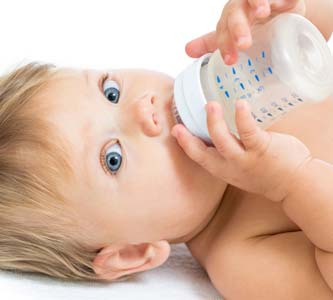
The carious lesions of the deciduous teeth can cause pain and damage the permanent teeth that are about to errupt.
Prevention of early caries in infants
The occurrence of caries during infancy can be minimized by informing the mother, that she should never allow her baby to fall asleep while breastfeeding or feeding with a nursing bottle.
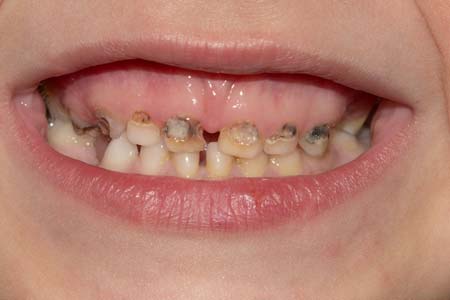
For babies that need the nursing bottle to help them fall asleep, it is preferable to fill them with water and not milk, or use a pacifier.
At Dental Group we strive to eliminate baby bottle tooth decay and raise the awareness among parents regarding prevention issues. We inform the parents that they should regularly examine their babies’ mouth for any suspicious signs of decay or anything unusual or abnormal.
The prolonged use of a pacifier or the prolonged sucking of the thumb can affect the occlusion of the jaws in a negative way, since they prevent the permanent teeth from errupting in the right place.

The pediatric dentists of the Dental Group network recommend various ways to help children quit these harmful habits. Such methods are the outbound of the feeling of guilt, the support from the family, the keeping of a diary and the rewarding of the child. Another important way of approach that plays a significant role in quitting these bad habits is the honest communication between the pediatric dentist and the child. Finally, in complicated and tough cases the use of a simple orthodontic appliance could be very helpful.
From a very early age, even right after birth, parents must clean the gums of their baby with the use of a soft and smooth gauze and water or a soft special silicon brush.
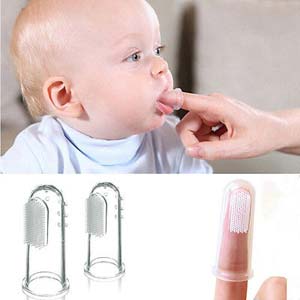
When the first teeth errupt, parents should brush them gently, twice a day, applying a trace of fluoride toothpaste (lentil sized quantity). They should get advice from the pediatric dentist on the time suitable for initiating this kind of baby care. The dentist will also show them how to brush their baby’s teeth.
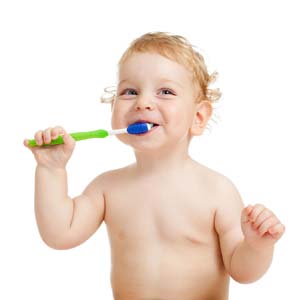
When infants reach the ages of 3-6 years old, we advise the increase of the quantity of toothpaste used, equal to a pea sized quantity and parents must help or supervise the child while brushing his/her teeth.
We must take under consideration that young children cannot brush their teeth effectively. It is best that we first brush our child’s teeth and leave them alone in the process to brush their teeth. Finally, we should take care that they don’t swallow toothpaste.
The brushing of the teeth should take place daily, 2-3 times a day, after every meal and definitely before bedtime.
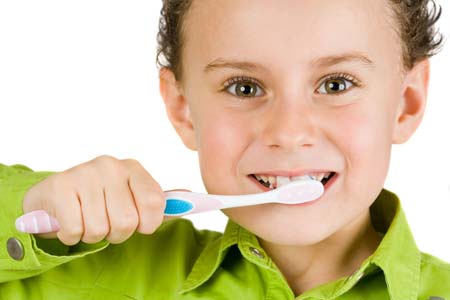
Brushing is performed with round movements by keeping the toothbrush with an angle against the teeth. All surfaces of the teeth, the external, internal and occlusal need to be brushed. In order to have enough time to brush all surfaces brushing should last at least 2-3 minutes.

Brushing is performed with round movements by keeping the toothbrush with an angle against the teeth. All surfaces of the teeth, the external, internal and occlusal need to be brushed. In order to have enough time to brush all surfaces brushing should last at least 2-3 minutes.
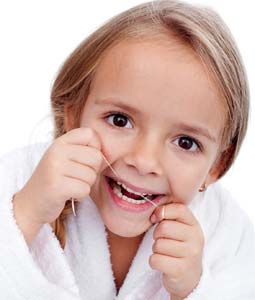

Oral health is highly impacted by the children’s nutritional habits. For the correct development of the teeth as well as for healthy gums a balanced diet is compulsory. A diet that contains an increased quantity of sugar increases the risk of developing caries. Parents owe to supervise what their child eats daily and suggest alternative snacks and meals. We encourage parents to talk to the pediatric dentist or other specialized members of the Dental Group’s network for getting information on the correct nutritional habits of their child and the reinforcement of their child’s oral health.
The baby teeth (deciduous) are as important as the permanent teeth. They are necessary in speech, chewing of foods and appearance. Moreover, the deciduous teeth maintain the spaces in the jaw for the erruption of the permanent teeth. Consequently, their neglected care with the excuse that they will be replaced by the permanent teeth is a misconception. The healthy teeth of a child are the base for the healthy oral condition of an adult.
When the teeth develop carious lesions, an infected environment is created in the oral cavity that can affect negatively the permanent teeth that haven’t errupted yet. But even the general health of the children can be affected by inflammations and abscesses. The treatment of the teeth relieves the pain and restores the healthy condition of the teeth and the gums, providing a better quality of life to the child.
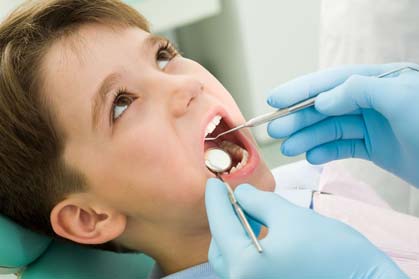
The objective of the dental treatment is for the baby teeth to remain in the oral cavity as long as necessary. The early loss of a tooth allows the movement of the adjacent teeth, resulting in the closure of the space intended for the permanent tooth. In this case, the permanent tooth may errupt in a wrong position. For this reason, in cases of an early tooth loss the pediatric dentist or the orthodontist recommends the placement of a space maintainer, until the permanent tooth starts errupting.
In cases where the nerve of the tooth has been infected as well, a pulpotomy may also be required. The pediatric dentist always informs the parents about the available options and answers to questions regarding the dental procedures.
The X-rays provide the ability to the pediatric dentist to diagnose and treat dental problems that may not be possible just by clinical examination.
At Dental Group a radiograph is recommended for a child only if it is absolutely necessary. In this case, all safety measures are taken including: a) the use of a protective lead apron and collar and b) the reduction of the radiation dose.
At Dental Group we are always at your disposal in case of a dental emergency. Bellow you will find some instructions that may be helpful in dental emergency situations
- What can I do when a tooth gets knocked out?
- What can I do if my child breaks a tooth?
- What should I do if my child bites his/her tongue or lip or cheek?
- How can my child prevent himself/herself from a tooth trauma?
- What can I do if my child suffers from toothache?
- What should I do in case of a hemorrhage after tooth extraction?
- What should I do if an object gets stuck between the teeth?
If it is a permanent tooth, wash gently the tooth without touching the root. If it is possible, put the tooth back in its place and tell the child to hold it tightly by biting on a clean gauze. Otherwise, put the tooth in a small container filled with milk or water. You should contact immediately the dentists of Dental Group at any time of the day. The tooth has a small likelihood to be saved only if you act right away and visit your pediatric dentist in the following 30 minutes.
It is generally advised that you put some ice on the traumatized area every 10-15 minutes. In case of a hemorrhage press with a sterile gauze or a clean wipe. If the hemorrhage continues even after 10 minutes have passed, then contact Dental Group.
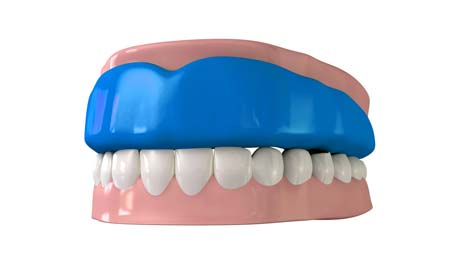

Why should I visit a pediatric dentist?
The pediatric dentist is a dentist specialized for children from childhood to adolescence. The pediatric dentist after graduation from the Dental School has attended a 3 year specialization training program. Besides from the scientific knowledge in dentistry a pediatric dentist is trained in the management of specific behaviors of children and especially fear of the dentist.
Infants, young children and adolescents, as compared to adult patients, require a different approach during dental treatment and education.
At Dental Group we try to establish an essential relationship between the children and the pediatric dentists, because it is our belief that the early diagnosis and treatment will reduce the occurrence of more severe problems in the future.
When should the first visit at the pediatric dentist take place?
The first visit at the pediatric dentist should take place when the first tooth errupts, at about the age of six months, and not later than the baby’s first birthday.
How often should my child visit the pediatric dentist?
The official recommendation of the international dental community is that the child should visit the dentist twice a year for an examination and cleaning session. At Dental Group we follow the aforementioned guideline to ensure the child’s dental health.
How should I take care of my baby's deciduous teeth?
From a very early age, even right after birth, parents must clean the gums of their baby with the use of a soft and smooth gauze and water or a soft special silicon brush.
When the first teeth errupt, parents should brush them gently, twice a day, applying a trace of fluoride toothpaste (lentil sized quantity).
When infants reach the ages of 3-6 yeas old, we advice the increase of the quantity of toothpaste used, equal to a pea sized quantity and parents must help or supervise the child while brushing his/her teeth.
We must take under consideration that young children cannot brush their teeth effectively. It is best that we first brush our child’s teeth and leave them alone in the process to brush their teeth. Finally, we should take care that they don’t swallow toothpaste.
The brushing of the teeth should take place daily, 2-3 times a day, after every meal and definitely before bedtime.
Why are deciduous teeth so important?
Baby teeth (deciduous) are equally important as permanent teeth. They are necessary for speech, chewing of foods and appearance. Additionally, deciduous teeth maintain the spaces intended for the erruption of the permanent teeth. Consequently, the neglect with the excuse that they will be replaced by the permanent teeth is wrong. The healthy deciduous teeth are the basis for a healthy adult mouth.
What are the preventive fillings (sealants)?
Preventive fillings (sealants) are transparent or opaque thin resin fillings that are placed by the pediatric dentist on the chewing surfaces of the back teeth, mainly of children and adolescents, for the protection against caries.
How long do preventive fillings (sealants) last?
The preventive fillings, generally, have a long life span if they have been placed correctly. Effective oral hygiene also plays an important role in the duration of the result. During the regular examinations, the dentist examines if the preventive sealants are intact or detached. In such a case and if necessary, the sealant fillings are usually replaced.
On what kind of teeth preventive fillings can be placed?
The occlusal surfaces of the back teeth (molars and premolars) are not smooth, but have deep grooves that trap food and bacteria. Due to the limited access of these areas, many times, these teeth are not cleaned properly, especially when it comes to children. Hence, these areas are more prone to develop carious lesions and therefore are the areas where preventive fillings should be placed.
Are preventive fillings an innovation in dentistry?
No, they are not something new. They are used for more than 25 years. Nevertheless, many people are unaware of their existence.
Do preventive fillings protect from caries in areas between adjacent teeth?
Unfortunately, only the chewing surfaces are protected from caries with the use of preventive fillings.
Is brushing and use of dental floss necessary when preventive fillings have been placed?
Brushing and the use of dental floss are always necessary. Preventive fillings alone cannot protect against caries. The thorough oral hygiene practice, the balanced diet and the regular dental visits are also very important.


